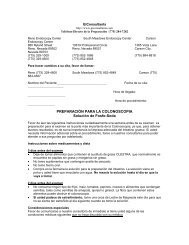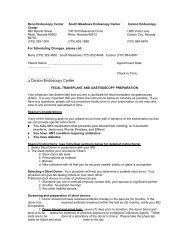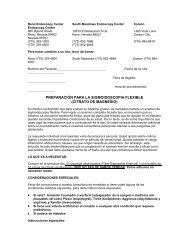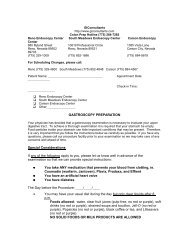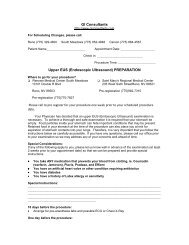Endoscopic Ultrasound–Guided Fine Needle Aspiration Cytology of ...
Endoscopic Ultrasound–Guided Fine Needle Aspiration Cytology of ...
Endoscopic Ultrasound–Guided Fine Needle Aspiration Cytology of ...
You also want an ePaper? Increase the reach of your titles
YUMPU automatically turns print PDFs into web optimized ePapers that Google loves.
1980 DeWitt et al. AJG – Vol. 98, No. 9, 2003<br />
FNA <strong>of</strong> the liver. Furthermore, we do not routinely place<br />
patients on their right side during recovery before discharge.<br />
A recent series (5) describing the use <strong>of</strong> P-FNA in the<br />
diagnosis <strong>of</strong> 216 liver tumors reported the occurrence <strong>of</strong><br />
implantation metastases in seven patients (3%) a median 4<br />
months (range 2–49 months) after P-FNA <strong>of</strong> liver masses<br />
from colorectal cancer (n 5), gallbladder carcinoma (n <br />
1), and a hepatoma (n 1). In addition, the implantation<br />
metastases caused major problems locally and were fatal in<br />
four patients. This complication has not been described after<br />
EUS-FNA <strong>of</strong> the liver. The true incidence <strong>of</strong> implantation<br />
metastases after EUS-FNA <strong>of</strong> the liver, however, is difficult<br />
to estimate, inasmuch as hepatic metastases from pancreatic<br />
malignancy (which comprise 87% <strong>of</strong> malignancies in our<br />
study) usually carry a dismal prognosis and are managed<br />
nonoperatively. Therefore, as the overwhelming majority <strong>of</strong><br />
patients diagnosed with <strong>of</strong> hepatic metastases after EUS-<br />
FNA <strong>of</strong> the liver do not undergo intended curative resection,<br />
the true incidence <strong>of</strong> this complication is not known. The<br />
most common malignancies diagnosed by P-FNA (colorectal<br />
metastases and primary hepatomas) are <strong>of</strong>ten managed<br />
surgically with curative intent. We believe that these fundamental<br />
differences partially explain the disparity in reported<br />
incidence <strong>of</strong> implantation metastases between EUS-<br />
FNA and P-FNA <strong>of</strong> liver masses. Studies comparing the<br />
diagnostic accuracy and complications EUS-FNA and P-<br />
FNA <strong>of</strong> all types <strong>of</strong> suspected liver tumors are needed to<br />
resolve these issues.<br />
The overall sensitivity <strong>of</strong> transabominal US for the detection<br />
<strong>of</strong> liver metastases is reportedly between 80% and<br />
90% (22, 23). Recent studies using helical CT and magnetic<br />
resonance imaging, however, show that noninvasive imaging<br />
is relatively insensitive for lesions 1 cm(24–26). By<br />
EUS and EUS-FNA, we detected 17 malignant hepatic<br />
lesions (mean 12.6 mm, range 3–26 mm) with a previously<br />
normal CT alone (n 13), CT and US (n 3), or US alone<br />
(n 1). Of these, six (35%) were 1 cm in diameter. These<br />
17 lesions were found in 41% <strong>of</strong> the 42 patients with<br />
available radiographic imaging information performed before<br />
EUS. Nguyen et al. (11) reported that CT performed<br />
before EUS-FNA <strong>of</strong> the liver failed to detect liver lesions in<br />
11 <strong>of</strong> 14 patients (79%). Collectively, these results demonstrate<br />
the utility <strong>of</strong> EUS-FNA for the detection <strong>of</strong> malignant<br />
liver lesions that have been missed by prior radiographic<br />
imaging. Further comparative studies are needed to determine<br />
whether other imaging modalities such as fluorine-18<br />
fluorodeoxyglucose positron emission tomography (27),<br />
magnetic resonance imaging (28), harmonic ultrasound imaging<br />
(29), or ultrasound contrast agents (30) <strong>of</strong>fer any<br />
advantages over EUS for detection <strong>of</strong> occult or subcentimeter<br />
liver metastases.<br />
When compared with benign lesions, we found that malignant<br />
lesions detected by EUS-FNA <strong>of</strong> the liver were more<br />
likely to have regular margins (60% vs 27%; p 0.02) and<br />
to be accompanied by at least one other lesion detected on<br />
EUS (38% vs 9%; p 0.03). Furthermore, no statistically<br />
significant difference was found with regard to site <strong>of</strong> biopsy<br />
(p 0.57), size (p 0.70), echogenicity (p 0.36), or<br />
number <strong>of</strong> passes performed (p 0.44) for these lesions.<br />
Although EUS features <strong>of</strong> malignant lymphadenopathy have<br />
been described (31), to our knowledge the endosonographic<br />
features for malignant liver lesions have not been previously<br />
reported. These findings may help to guide decision making<br />
and assessment <strong>of</strong> the risk/benefit ratio <strong>of</strong> EUS-FNA <strong>of</strong><br />
hepatic masses.<br />
In conclusion, the results <strong>of</strong> our study show that the<br />
sensitivity <strong>of</strong> EUS-FNA <strong>of</strong> the liver for the diagnosis <strong>of</strong><br />
malignancy ranges from 82% to 94% and that, contrary to<br />
previous reports, it is a safe procedure. When malignancy is<br />
diagnosed, EUS-FNA <strong>of</strong> the liver significantly affects patient<br />
management and implies a poor overall prognosis.<br />
EUS features predictive <strong>of</strong> malignant hepatic masses are the<br />
presence <strong>of</strong> regular outer margins and the detection <strong>of</strong> two<br />
or more lesions. In this series, EUS and EUS-FNA detected<br />
malignant liver tumors that were not seen by CT or US (or<br />
both) in 41% <strong>of</strong> subjects. Therefore, surveillance <strong>of</strong> the<br />
entire liver is indicated during evaluation <strong>of</strong> known or<br />
suspected malignancy. Prospective studies are needed to<br />
compare the accuracy and complication rate <strong>of</strong> EUS-FNA<br />
and P-FNA for the diagnosis <strong>of</strong> liver tumors.<br />
Reprint requests and correspondence: John M. DeWitt, M.D.,<br />
Department <strong>of</strong> Medicine, Division <strong>of</strong> Gastroenterology, Indiana<br />
University Medical Center, 550 N. University Boulevard, UH<br />
4100, Indianapolis, IN 46202-5121.<br />
Received Nov. 11, 2002; accepted Jan. 30, 2003.<br />
REFERENCES<br />
1. Tatsuta M, Yamamoto R, Kasugai H, et al. Cytohistologic<br />
diagnosis <strong>of</strong> neoplasms <strong>of</strong> the liver by ultrasonically guided<br />
fine-needle aspiration biopsy. Cancer 1984;54:1682–6.<br />
2. Buscarini L, Fornari F, Bolondi L, et al. Ultrasound-guided<br />
fine-needle biopsy <strong>of</strong> focal liver lesions: Techniques, diagnostic<br />
accuracy and complications. A retrospective study on 2091<br />
biopsies. J Hepatol 1990;11:344–8.<br />
3. Edoute Y, Ben-Haim S, Brenner B, et al. Fatal hemoperitoneum<br />
after fine-needle aspiration <strong>of</strong> a liver metastases. Am J<br />
Gastroenterol 1992;87:358–9.<br />
4. Kowdley KV, Aggarwal A, Sachs PB. Delayed hemorrhage<br />
after percutaneous liver biopsy: Role <strong>of</strong> therapeutic angiography.<br />
J Clin Gastroenterol 1994;19:50–3.<br />
5. Ohlsson B, Nilsson J, Stenram U. Percutaneous fine-needle<br />
aspiration cytology in the diagnosis and management <strong>of</strong> liver<br />
tumors. Br J Surg 2002;89:757–62.<br />
6. Goletti O, Chiarugi M, Buccianti P, et al. Subcutaneous implantation<br />
<strong>of</strong> liver metastasis after fine needle biopsy. Eur<br />
J Surg Oncol 1992;18:636–7.<br />
7. Scheele J, Alterndorf-H<strong>of</strong>mann A. Tumor implantation from<br />
needle biopsy <strong>of</strong> hepatic metastases. Hepato-Gastroenterology<br />
1990;37:335–7.<br />
8. Andersson R, Andren-Sanberg A, Lundstedt C, et al. Implantation<br />
metastases from gastrointestinal cancer after percutaneous<br />
puncture or biliary drainage. Eur J Surg 1996;162:551–4.<br />
9. Wiersema MJ, Vilmann P, Giovannini M, et al. Endosonography-guided<br />
fine needle aspiration biopsy: Diagnostic accu-




